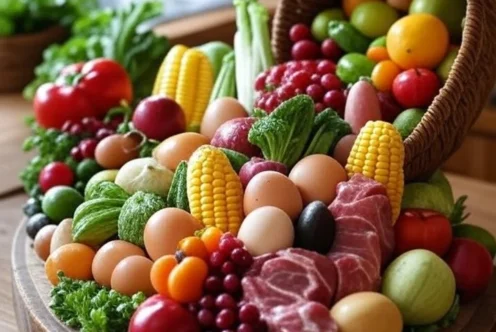Blog
Smart Savings at the Supermarket!

When it comes to managing your household budget, groceries can take a sizable chunk out of your finances. However, by implementing some strategic shopping tips and paying more attention to what you buy, you can slice off as much as $100 or more from your overall food costs each month. Saving at the supermarket is essential; after all, we all need to eat! Let’s dive into the art of saving money at the grocery store. Whether you’re budgeting for a family or just trying to stretch your dollar, we’ve got you covered with practical tips and tricks.
1. Plan Your Meals
One of the most effective strategies to save on groceries is to create a weekly meal plan. Focus on what you already have in your pantry and freezer, as well as what’s on sale at your local grocery store. Having a plan reduces the likelihood of impulse buying and encourages you to utilize items you already have on hand.
Interestingly, the average person typically eats about eight different dinner-time meals and even less variety for lunch and breakfast. Crafting a meal plan based on those staples can streamline your shopping, making it easier to stick to what you need rather than wandering the aisles aimlessly.
Additionally, consider shopping the perimeter of the store where essential staples like dairy products, eggs, proteins, fruits, and vegetables are usually located. This method not only focuses your purchases on fresh, nutritious foods but also helps you avoid paying for unnecessary processing on items that are not essential for your nutritional needs.
2. Use a Shopping List
Stick to a shopping list to minimize unnecessary purchases. Writing down what you need—either using apps or traditional pen and paper—can help you stay focused and avoid those tempting impulse buys that can add up quickly. Studies have shown that shoppers who use lists tend to spend less money overall, as they are less likely to stray from their intended purchases.
3. Shop Seasonally and Locally
Buying seasonal and local produce is another smart way to save money. Seasonal fruits and vegetables are not only cheaper but also fresher and tastier. For instance, if you’re shopping in Arizona, local dairy products are often marked with “04” on the top of the milk carton, indicating they were processed locally and are fresh. Farm-to-table products take less time to arrive at the store, which usually translates to better quality.
Additionally, purchasing local products helps support your community’s economy by directing your spending towards local farmers and businesses. Resources like the USDA Seasonal Produce Guide can help you understand what’s in season and available for purchase in your region.
4. Go for Store Brands
Don’t overlook store brands when shopping. These products are often significantly cheaper than name brands and can be just as high in quality. In many cases, store brands are produced by the same manufacturers as their name-brand counterparts but are sold at a lower price due to reduced marketing expenses. Checking the ingredients list can help you compare the quality and make informed decisions.
5. Bulk Buying for Non-Perishables
Items such as rice, pasta, canned goods, and spices can often be purchased in bulk for considerable savings. However, this tactic only works well if you have enough storage space and will use these items before their expiration dates. If you find bulk bargains on items that can be frozen—like meats and certain vegetables—this can extend your budget substantially.
Be cautious, however, not to overbuy. There’s no savings if you’re ending up throwing food away. Consider purchasing a mix of bulk items and smaller packages depending on your household’s needs.
6. Price Comparison and Coupons
Using apps or websites to compare prices across different stores can lead to notable savings. Many shoppers have turned to digital coupons or cashback apps that track discounts and offers available at various retailers. Don’t forget the old-fashioned method of checking weekly circulars; many people still plan their meals around which store items are on sale.
Also, make it a habit to shop both high and low on the shelves. Many of the best deals are often placed at eye level and can be overlooked if you’re not paying attention.
7. Shop at Discount Stores
Stores like Sam’s Club and Costco can offer lower prices on groceries than traditional supermarkets. Membership fees to these stores can often pay for themselves in savings on bulk purchases. Don’t neglect local farmers’ markets, which can provide fresh produce at lower prices than grocery stores, especially if you’re savvy about timing.
Buying near closing time can yield fantastic deals as farmers often reduce prices to avoid taking their produce back home.
8. Avoid Pre-Packaged and Processed Foods
Pre-packaged and processed foods typically carry higher price tags and have lower nutritional value. Buying individual ingredients and cooking meals from scratch can save you money while also providing healthier options for your family. Furthermore, always evaluate the nutritional value of the items you decide to purchase.
While convenient, many pre-packaged foods are often favorites for kids but can be packed with excessive sugar and lack the necessary nutrients. Consider making homemade meals based on your meal plan, which is often healthier and more satisfying.
9. Loyalty Programs
Almost all supermarkets have loyalty programs that offer discounts, cashback, or special deals. Signing up for these can lead to quick savings on your grocery bill. It can also be beneficial to mix up the grocery stores you visit based on the discounts being offered that week.
10. Freeze and Preserve
If you discover good deals on items that can be frozen, such as meats or certain fruits and vegetables, seize the opportunity to buy in bulk. Properly freezing items can extend their shelf life and save you money in the long run. This strategy can also apply to cooking large batches of meals and freezing individual portions for future use.
A practical example to consider is evaluating the difference in cost between buying a pre-cut chicken versus a whole chicken. A whole chicken is typically more economical and can be cut into various parts at home. If this isn’t a skill you possess, you might want to consider learning from a friend who cuts their own meats and can share tips.
11. Grow Your Own
Growing your own herbs and vegetables is a rewarding way to save money in the long run. While this requires time and commitment, many home gardeners appreciate the personal value of cultivating their own food.
If space is a constraint, even a small herb garden on a windowsill can significantly reduce your spending on fresh herbs. Before diving in, consider your gardening skills; if you lack a green thumb, it’s perfectly okay to skip this option and find alternatives.
12. Check Unit Prices
The price tag isn’t always a reliable indicator of value—sometimes, larger packages aren’t cheaper when you compare the price per ounce or gram. Always check the unit price prominently marked on the shelf beneath the main price tag. This detail can help you make the best purchasing decisions.

13. Avoid Shopping on an Empty Stomach
Shopping while hungry can lead to unplanned purchases of items that are not on your list. When you’re hungry, it’s easy to indulge in impulse buys of expenses higher on less healthy options. Moreover, many stores know this tactic and often place staples like milk at the back of the store to draw you further in.
14. Use Cashback and Reward Apps
With the rise of digital technology, there are numerous apps now available that allow you to earn cashback or rewards for shopping. These are known as cashback apps and can provide additional savings on your grocery bills. Apps such as Ibotta or Rakuten often feature special deals at grocery stores that can supplement your normal savings.
15. Plan Around Sales and Discounts
In addition to checking weekly circulars, consider building your meal plan around the sales and discounts offered at local supermarkets. By planning meals that incorporate discounted items, you’ll not only save more but also have an exciting variety of meals throughout the week.
16. Educate Yourself About Pricing Trends
Being knowledgeable about pricing trends over time can give you an advantage when it comes to spotting good deals. Keeping track of what items typically cost helps you recognize when prices are significantly marked down. Many shoppers find it helpful to keep a grocery notebook or spreadsheet for tracking, which can lead to deeper insights into their shopping habits.
17. Add Some Budget Flexibility for High-Quality Items
While saving money is important, keep in mind that sometimes splurging on higher-quality items can be a worthwhile investment. For instance, purchasing sustainably caught fish may be more beneficial in the long term, both for your health and the environment.
18. Use Technology to Your Advantage
There are now many tech-savvy tools to help save money at the grocery store. Price comparison apps, grocery store apps with digital coupons, and budgeting apps can streamline your shopping experience. Invest some time in downloading, exploring, and utilizing these technologies to maximize your savings.
19. Create a Grocery Budget
Setting a specific grocery budget can foster better spending habits. Determine how much money you can dedicate to groceries each month based on your income and expenses. Stick to this budget while being flexible enough to make adjustments as necessary—extra expenses may occur, but having a firm budget in place helps you avoid overspending.
20. Encouraging Family Involvement
Involve your family in the budgeting and meal-planning process to instill the value of mindful spending. By engaging kids in grocery store outings, you’re teaching them about nutrition, budgeting, and food diary management from a young age. This makes saving money a shared responsibility and can lead to more enjoyable family meals as they’ll be more invested in the process.
Conclusion
Implementing these strategies in your grocery shopping routine can lead to significant savings each month. The key is to adopt a combination of planning, awareness, and mindful consumption while keeping your family’s nutritional needs at the forefront. Remember, small changes can add up over time, leading to substantial savings. By equipping yourself with the right knowledge, you’re taking a big step towards financial health while still enjoying delicious and nutritious meals. Happy shopping!
By Arizona Milk Producers General Manager Tammy Baker and Arizona Farm Bureau Communications Director Julie Murphree


















